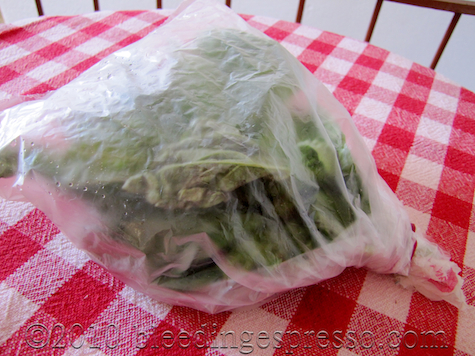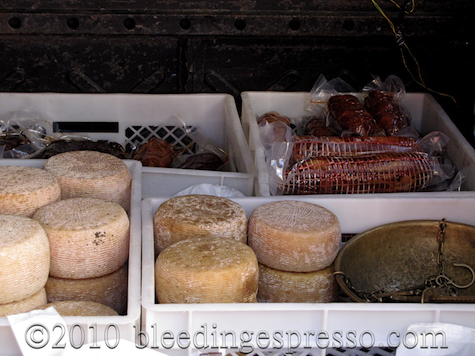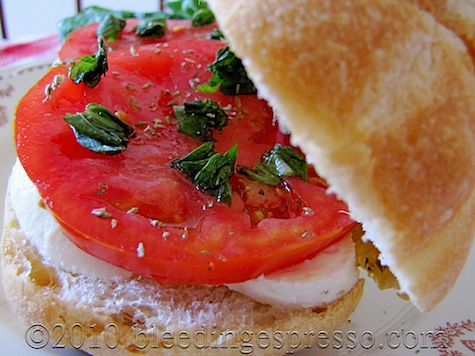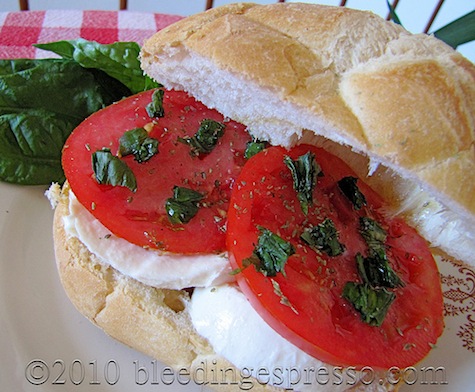Archive for the ‘food’ Category
How to Store Fresh Cut Basil
As we’re at the height of basil season here, I thought I’d share with you my method for how to keep basil fresh after it has been cut from the plant.
I’ve tried all kinds of ways over the years, and this is what I have found works best:
1. Wrap the stems in a damp paper towel.
2. Put a plastic bag over the unwashed leaves and secure with a rubber band at the base.
3. Place the basil in the refrigerator.
4. Pluck off leaves as you need them, washing just before use.
With this method, I have kept basil fresh for up to two weeks in the refrigerator, but you do want to keep an eye on it if you’re not using it immediately. Be sure to re-wet the paper towel when it’s going dry and also remove any leaves that are turning black and/or slimy; they will get moldy if left in there too long.
If you still aren’t using your basil quickly enough before it goes off, wash and pat dry the basil then tear off the leaves and pop them in a freezer bag. The leaves won’t be great for something like a Caprese Salad once they’re thawed, but they’ll still add great basil taste to soups and dishes like our Borlotti Beans alla Calabrese — and they do retain excellent flavor for about four to six months.
What are your favorite food storage tips?
Calabria Traveling Market: Buying Pecorino, Capocollo, ‘Nduja, and Pancetta from the Back of a Car
In Calabria, some days you go to the market. On other days you’re innocently typing away on your computer when you hear the cry of “Formaggio formaggio formaggio paesanoooo!” outside.
On those days, the market has come to you. So you grab your wallet and camera (no need for keys — you can just leave those in the lock in the front door), and head outside to see your choices.
Here was the selection yesterday morning:
This is all homemade and handmade locally by the seller and his wife.
Here he is weighing my capocollo and pancetta:
Yes, I decided to splurge and get pecorino, capocollo, and pancetta. Paolo and his friends have been working hard in our campagna (which means they need food up there every day) and most of his family is also around this month, so it’s good to have reserves in the house for drop-ins.
Homemade “paesano” salumi and cheese doesn’t come cheap, but it’s worth every centesimo. Still, the guy could sense my reluctance to part with my euros (may have been due to my price-haggling), so he threw in a big chunk of ‘nduja for free. You can see it a bit in the upper left of this photo:
What’s that? You’re not familiar with ‘nduja (ahn-DOO-ya)? Guess I’ll have to write a blog post about it, but for now, suffice it to say that it’s a Calabrian treasure — an uber-spicy, spreadable sausage that works well on everything from bruschetta to pasta.
And if you want a refresher course on the differences between pancetta, capocollo, our beloved suppressata, and more, check out Vince Scordo’s Guide to Cured Italian Meats: Salumi.
How would you enjoy the pecorino and salumi I picked up at the traveling market?
Panino Caprese: Tomato, Mozzarella, and Basil Sandwich
One of our summer staples around here is the Caprese Salad, but sometimes you just want something you can hold in your hand . . . enter the panino caprese.
As with many Italian dishes, the quality of ingredients in this week’s What’s Cooking Wednesday is extremely important, so you should use the best tomatoes (homegrown off the vine), mozzarella (di bufala) and olive oil (extra virgin) you can find. Basil, oregano, and salt round out the ingredients.
I like to put some olive oil on each inside of the bun to start, but you can assemble this any way you like. I do sliced mozzarella first, then sliced tomatoes, then basil, oregano, and salt — with another drizzle of olive oil over the tomatoes to finish it off.
Remember, “panino” in Italy just means a sandwich — it can be on any kind of bread or roll and certainly doesn’t need to be pressed in a grill. That said, you are more than welcome to heat up your panino caprese as that’s tasty as well.
And if you want to whip up some focaccia seasoned with olive oil and oregano (even thyme, yum!) for this sandwich, you won’t be disappointed; indeed, the first time I had one of these, it was at Dean & Deluca in New York City. Love at first bite doesn’t begin to describe it.
Buon appetito!
Win a Bag of Café Orzo: The Italian Caffeine-Free Alternative to Coffee
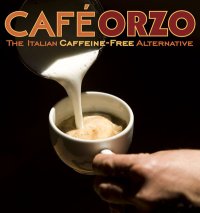 If you’ve been in a bar in Italy, you may have heard someone order “un caffè d’orzo” instead of a plain old un caffè.
If you’ve been in a bar in Italy, you may have heard someone order “un caffè d’orzo” instead of a plain old un caffè.
What is orzo?
Orzo is roasted barley, naturally caffeine-free, and DEEE-licious. I drink orzo from time to time, although I normally make it with milk into an orzo latte or orzoccino instead of drinking it like coffee — but you can certainly just put it in your coffee or espresso maker (it’s brewed the same way) and drink it “straight” like un caffè.
Where can I find orzo?
If you’re in Italy, it’s sold next to coffee in the grocery store or, of course, at the bar, but if you’re in the United States, you can now find Café Orzo in American coffee shops, cafes, and restaurants.
Café Orzo is made by two leaves and a bud, the award-winning tea company based in Colorado. They were kind enough to send me a sample when I was in the U.S., and it tasted just like what I knew in Italy. That is, YUM.
If you can’t get Café Orzo in your favorite establishment, why not tell the management about it?
What does orzo taste like?
As Café Orzo explains on its Facebook page:
It’s much richer than tea, and while we consider it an alternative to coffee, its flavor is distinctly different. Café Orzo has an earthy, nutty taste, and naturally occurring sugars in the barley impart a slight sweetness.
Couldn’t have said it better myself. I personally consider orzo a whole different drink from coffee or tea — something truly in a class all by itself.
You can also follow two leaves and a bud on Facebook, by the way.
 Where does Café Orzo come from?
Where does Café Orzo come from?
Café Orzo is 100% certified organic roasted barley that grows on small farms in Italy, near the Adriatic Sea and is artisan roasted in small batches. Yes — you’re getting the real thing from the Bel Paese.
Isn’t “orzo” a type of pasta?
Some Americans and others may know orzo as a type of small soup pasta, and indeed there is a pasta by this name, but don’t be fooled when you’re in a bar in Italy, where it’s roasted barley. In other words, if you order orzo here in a bar, you won’t get a cup of rice-like pasta, I promise.
Didn’t you mention a giveaway?
Yes!
Just comment* here with how you would enjoy your Café Orzo if you won a bag (if you’re not sure of the possibilities, check out the recipes) by 11:59 p.m. next Sunday, July 25, 2010, and you will be entered in the random drawing for a bag of Café Orzo direct from the company.
For extra chances to win, be sure to check in over at the Bleeding Espresso page on Facebook!
* Sorry for international readers, but the giveaway is limited to those with United States shipping addresses for shipping/customs reasons. If you comment below but aren’t eligible for the drawing, please specify as such (a quick “international” notation will work).
Panino Con La Mortadella Fritta
Sounds fancy, eh? OK, then let’s stick with that instead of calling this week’s What’s Cooking Wednesday what it really is: a fried bologna sandwich. With senape!
Have you ever had un panino con la mortadella fritta? Even if you don’t normally like bologna, I highly recommend finding the best sliced mortadella you can, tearing it up into smaller pieces, frying it in a pan (no oil, just a hot pan), and then slapping it on a fresh Italian roll. Oh, and add mustard.
My grandmother used to make these whenever we wanted a substantial snack but didn’t know what else to eat. P had never had one of these babies before I came along — and yes, he turned up his nose at first. But then the smell of frying mortadella got to him. He rarely has a “raw” mortadella panino now.
And even though you have to turn the stove on, frying doesn’t take very long so this ends up being a super easy summer treat around here.
Oh, and while we’re talking sandwiches/panini, be sure to check out Sara’s (Ms Adventures in Italy) explanation of the difference between a panino in Italiano and a panino in America at Panini Happy. Great stuff!
Buon appetito!

